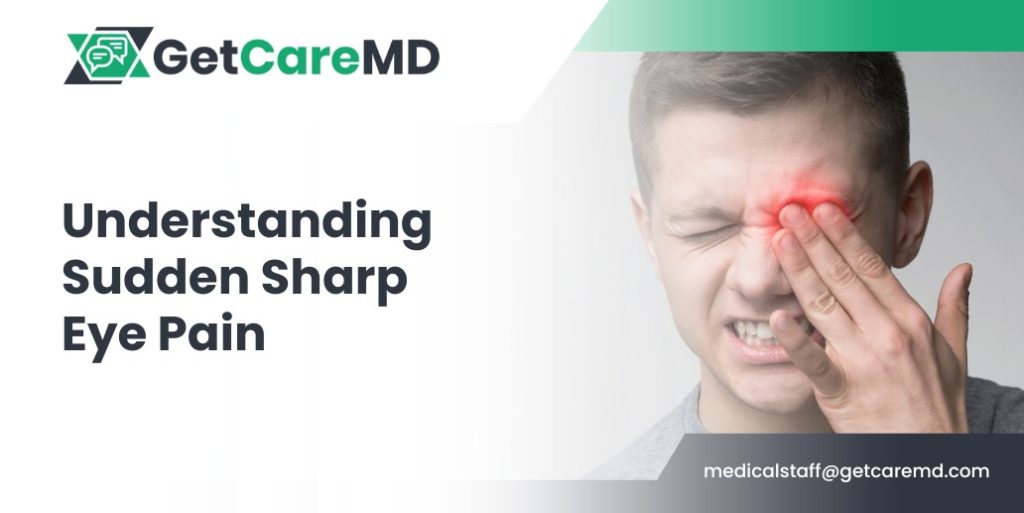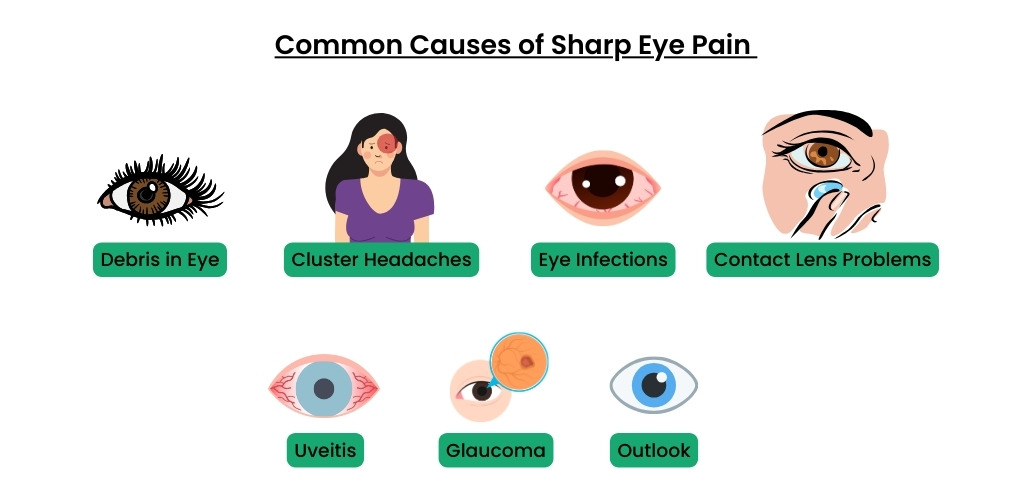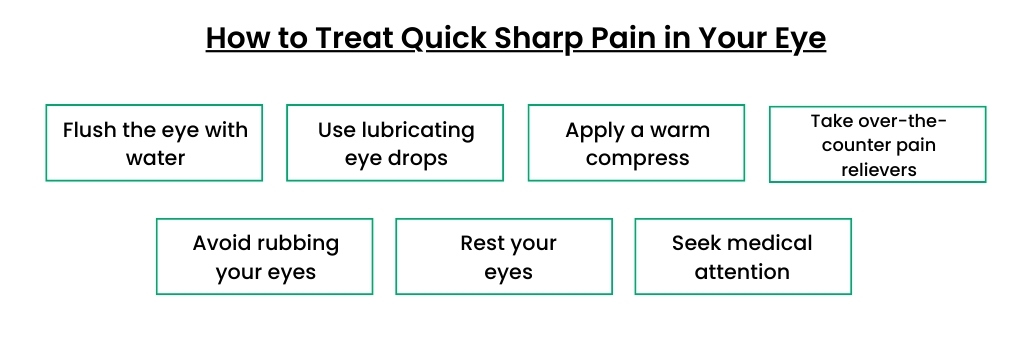Experiencing a sudden, sharp, stabbing pain in the eye can be alarming and uncomfortable. This type of pain, often described as a piercing or intense discomfort, can have various causes, ranging from minor issues to more serious conditions. Eye pain affects a significant portion of the population, with studies indicating that approximately 1-2% of people experience eye pain at some point in their lives.
Understanding the potential causes of this symptom is crucial for identifying the appropriate treatment and ensuring eye health. In this blog, we will explore the common reasons behind sudden eye pain and what steps you should take if you encounter this issue.
What’s the Sharp Stabbing Pain in Your Eye?
A sharp stabbing pain in the eye, often described as a “needle feeling in the eye,” can be an alarming experience. This type of pain typically feels like a quick, intense jab and can occur unexpectedly.
The sensation might be brief, lasting only a few seconds, or it can persist, causing significant discomfort. People experiencing this kind of eye pain often describe it as if a needle is piercing their eye, making it difficult to ignore.
This pain can affect different areas around the eye, including behind the eye, which can vary in intensity and frequency.
Sharp stabbing pain behind right eye: This specific type of pain is characterized by a sudden, piercing sensation located behind the right eye. It can feel like a sharp jab or a severe, concentrated discomfort that makes focusing or moving the eye challenging.
Sharp stabbing pain behind left eye: Similarly, this pain occurs behind the left eye and is marked by a sharp, intense sensation. It can feel like a quick, piercing stab that can disrupt daily activities and cause significant distress.
Can Anxiety Cause Sharp Eye Pain?
Anxiety can indeed contribute to sharp eye pain, manifesting as a “needle feeling in the eye” sensation. When a person experiences anxiety, their body’s stress response can lead to various physical symptoms, including muscle tension and increased eye strain. This tension can result in discomfort and pain around the eyes.
Additionally, anxiety can cause hyper-awareness of bodily sensations, making minor eye discomfort feel more intense. While anxiety might not directly cause severe eye conditions, it can exacerbate existing issues or make one more susceptible to noticing and being bothered by eye pain.
Understanding the link between anxiety and eye pain is essential for managing both effectively and ensuring overall well-being.
How Do You Know If Eye Pain is Serious?
Determining whether eye pain is serious requires careful attention to the symptoms and their context. While occasional discomfort might be harmless, certain signs indicate a need for immediate medical attention.
For instance, a sharp pain in the eye while sleeping could signal an underlying issue that needs to be addressed promptly. Recognizing these critical symptoms can help prevent potential complications and ensure proper treatment.
- Persistent or worsening eye pain that doesn’t improve with rest or over-the-counter medication.
- Sharp pain in the eye while sleeping, especially if it wakes you up or disrupts your sleep regularly.
- Sudden vision changes, such as blurriness, double vision, or loss of vision.
Eye pain is accompanied by other symptoms like headache, nausea, or sensitivity to light. - Redness, swelling, or discharge from the eye, which could indicate an infection or inflammation.
Common Causes of Sharp Eye Pain
Experiencing a shooting pain in the eye or a needle-poking sensation can be discomforting, and various factors can contribute to these sensations. Here are some common causes to be aware of:
Debris in Eye
Particles like dust, sand, or eyelashes can irritate the eye’s surface, leading to sharp pain and discomfort. Blinking or flushing the eye with water can often alleviate this type of discomfort, but if the pain persists, medical attention may be necessary to remove the debris safely.
Cluster Headaches
Cluster headaches can cause excruciating pain around one eye, often described as a stabbing or piercing sensation. These headaches typically occur in clusters or patterns, with periods of intense pain followed by remission. Seeking medical advice is crucial for managing cluster headaches effectively.
Eye Infections
Infections such as conjunctivitis (pink eye) or keratitis can cause sharp eye pain along with symptoms like redness, itching, and discharge. Prompt treatment with antibiotics or antiviral medications is necessary to alleviate the infection and prevent complications.
Contact Lens Problems
Wearing contact lenses incorrectly or for extended periods can lead to discomfort and sharp pain in the eye. Issues like dryness, irritation, or improper fit can cause abrasions on the cornea, requiring removal of the lenses and consultation with an eye care professional.
Uveitis
Uveitis, or inflammation of the uvea (the middle layer of the eye), can cause sharp, throbbing pain, along with redness, sensitivity to light, and blurred vision. Treatment typically involves anti-inflammatory medications to reduce inflammation and alleviate symptoms.
Glaucoma
Glaucoma, a condition characterized by increased pressure within the eye, can cause sharp eye pain, especially during acute episodes known as acute angle-closure glaucoma. Immediate medical attention is necessary to prevent permanent vision loss.
Outlook
While sharp eye pain can be distressing, many causes are treatable with prompt medical intervention. However, some conditions, such as glaucoma or optic neuritis, require ongoing management to prevent complications and preserve vision. If you experience persistent or severe eye pain, it’s essential to seek medical evaluation to determine the underlying cause and receive appropriate treatment.
How to Treat Quick Sharp Pain in Your Eye
Quick, sharp pain in your eye can be discomforting and disruptive, but several simple treatments can help alleviate the discomfort and promote healing. Here are some steps you can take to treat sharp eye pain: Flush the eye with water: If the pain is due to debris or irritants, flushing the eye with clean water can help remove the particles and alleviate discomfort.
Use lubricating eye drops: If dryness or irritation is causing the pain, lubricating eye drops can provide relief by moisturizing the eye’s surface and reducing friction.
Apply a warm compress: A warm compress can help soothe eye pain caused by conditions like styes or inflammation. Simply apply a clean, warm washcloth to the closed eyelid for a few minutes several times a day.
Take over-the-counter pain relievers: Non-prescription pain relievers like ibuprofen or acetaminophen can help reduce pain and inflammation associated with eye discomfort. Follow the dosage instructions carefully.
Avoid rubbing your eyes: Rubbing your eyes can exacerbate irritation and potentially cause further damage. Instead, try to resist the urge to rub and gently rinse your eyes with water if needed.
Rest your eyes: If eye strain or fatigue is causing sharp pain, taking breaks from screens or closing work and resting your eyes periodically can help alleviate discomfort and prevent further strain.
Seek medical attention: If the sharp eye pain persists, worsens, or is accompanied by other concerning symptoms such as vision changes or eye redness, it’s essential to seek prompt medical evaluation. A healthcare professional can diagnose the underlying cause of the pain and recommend appropriate treatment to address the issue effectively.
What is the Fastest Way to Bring Down Eye Pressure?
Lowering eye pressure quickly is essential for managing conditions like glaucoma, where elevated intraocular pressure can damage the optic nerve and lead to vision loss. While there isn’t a single “fastest” method to bring down eye pressure, certain treatments can help reduce pressure levels effectively.
These may include prescription eye drops specifically designed to lower intraocular pressure, oral medications, laser therapy, or surgical procedures. The most suitable treatment depends on various factors, including the severity of the condition and the individual’s overall eye health.
It’s crucial to consult with an eye care professional to determine the most appropriate and effective treatment plan for lowering eye pressure promptly and preserving vision.
Ending Note
experiencing sudden sharp stabbing pain in the eye can be alarming, but understanding the potential causes and appropriate treatment options is key to managing this symptom effectively. Whether it’s due to debris in the eye, underlying conditions like glaucoma or uveitis, or factors like eye strain or anxiety, seeking prompt medical attention is crucial for accurate diagnosis and treatment.
By staying informed and proactive about eye health, individuals can address sharp eye pain promptly, alleviate discomfort, and maintain optimal vision for the long term.



